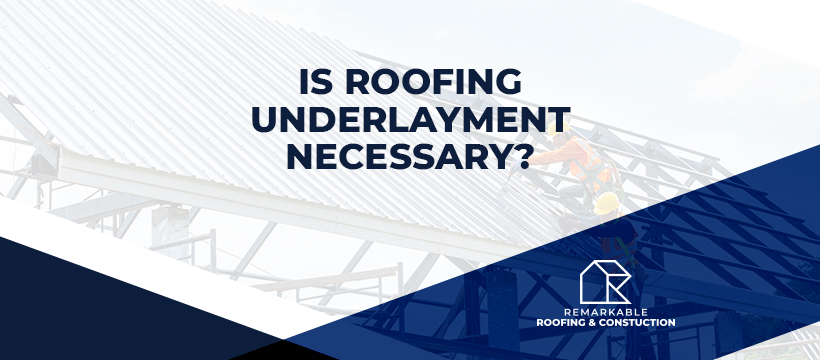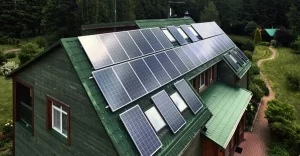Every homeowner knows how important a roof and its assisting factors are going to the architectural integrity and general attractiveness of their house. A roof helps keep inclement weather at bay. It safeguards the attic room, allowing for sufficient air-flow while insulating your property from your frosty during the cold months and excessive ambiance in the summertime.
Surprisingly, a durable roof goes beyond shingles. Find out more specifics of underlayment, a fundamental layer of the roof that helps make it dry and guarded against your elements.
Precisely What Is Roofing Underlayment?
Roofing underlayment is a barrier material that’s typically put in directly to your outdoor roof patio. Depending on how your property was constructed, the roof’s skeleton is comprised of rafters or trusses.
The outdoor roof patio, also sometimes called roof sheathing, maybe:
- Plywood
- OSB, or
- Phase sheathing
These boards are fastened on the rafters or trusses to help you balance the rafters or trusses and give construction towards the whole roof.
The roof structure underlayment is what goes in addition to this sheathing material. It gives you a secondary level of defense against dampness invasion should any water get under your shingles.
Forms of Roofing Underlayment
In general, there are three forms of roof structure underlayment: felt, self-adhered, and man-made. Everyone has their benefits and advantages. The type you choose generally depends on what your roofing contractor is more comfortable with and your local building rules and restrictions.
Felt Underlayment
This is among the most ancient forms of roof structure underlayment. It is commonly referred to as tar paper or felt paper. It is made from a natural pad or paper that has been soaked with asphalt to help you with water resistance.
Felt underlayment is often readily available as two standard weight loads:
15 lbs per hundred sq. ft . or No. 15 felt
30 lbs per hundred sq. ft . or No. 30 felt
For lightweight projects, No. 15 felt may be acceptable. However, it does damage very quickly, and in case it opens to the elements during the installment, it can absorb water and wrinkle.
For property owners who go for felt underlayment, contractors may advocate. No. 30 felt, which happens to be more durable than No. 15 felt. As with every from the underlayment products, it may be employed on numerous levels for more safety.
Some roofing companies commonly use felt underlayment when working with slate or tile shingles, although some may choose self-adhered underlayment. The location of the nation might determine it.
Self-Adhered Underlayment
These underlayments contain concrete asphalt and silicone polymers. It is a water-tolerant solution for roof structure underlayment.
Personal-adhered underlayments have got sticky back so that they can follow the outdoor roof patio. This sticky backing helps create a water-resistant seal between the outdoor roof patio and also the underlayment. This special underlayment is made to protect the roof from harm where water is likely to collect or where penetration in the outdoor roof patio is out there.
Instances of these problem-predisposed regions involve:
- Eaves
- Valleys
- Air vents
- Chimneys
- Skylights
Self-adhered underlayments are useful in areas that get severe winter weather.
The top surface area of this kind of roof structure underlayment might have granulated, polyethylene, or polyester components to offer weather-tolerant positive aspects. Furthermore, it creates a non-skid surface area, designed to be more secure for roofing companies to install, as it could be much easier for them to move around on.
Synthetic Underlayment
Throughout the previous ten years, roughly, man-made underlayment has been a preferred option for property owners. Although components may vary by producer, most man-made roof structure underlayment comprises numerous levels of numerous polymers stitched collectively.
Synthetic underlayments typically have several advantages
- Hard, resilient and damage-tolerant
- Lighter, with increased coverage per roll (compared to most other underlayment products), reducing step ladder outings
- Protect walking surface area
- Delineated lines and overlap guides for enhanced installment.
- It repels water, and it is inert to mold.
How Come Roofing Underlayment Necessary?
Within the never-concluding struggle against the elements that property owners and contractors wage, your shingles are certainly your first line of protection. Shingles might help reflect the sun’s rays, block precipitation, and endure substantial winds.
However, roof structure underlayment adds a level of safety that:
Safeguards your roof should your shingles damage-away because of substantial winds.
Assists protect your outdoor roof patio from harm as a result of ice dams during cold weather snaps.
Shields your roof from poor weather through the installation process before shingle bond
Your home’s roof structure program must feature a roof structure underlayment product and roof covering up to meet the local building codes. Also, shingle companies need underlayment as part of their warranty.
Read More About Roofing Underlayment
There exists a product range designed to use your shingles to protect your property. Search our man-made and self-adhered underlayment alternatives for more information.
Locate a Roofing Company In Your Town
Suppose you’re considering a re-roof task because your home’s roof is aging, or you’re embarking on a new design task. In that case, a roofing contractor might help respond to particular concerns you possess about underlayment, sheathing types, and other components that help make your residence shielded from wind and weather.
Try to find a completely independent roofing contractor in your area.







